The week Choisir took Ascot by storm


















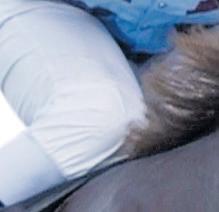
RACING POST special commemorative supplement in association with Inside
How the Australian star rocked Royal Ascot 20 years ago



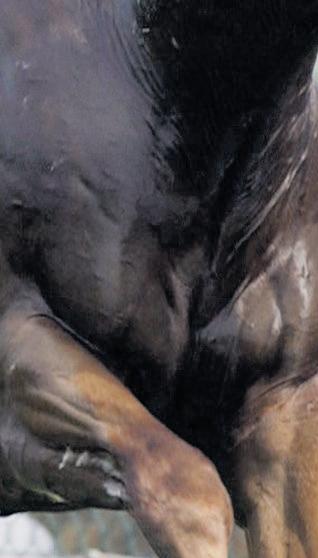



How Choisir achieved the impossible by the people who were there, pages 2-3 Australia's growing roll of honour at Royal Ascot, pages 4-5 Choisir, the humble hero who created a dynasty, pages 6-7





A land of racing opportunity for all in Australia, page 8
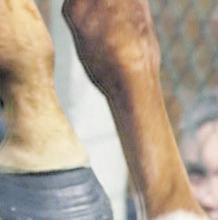
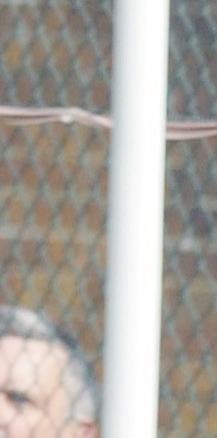














ADVERTISEMENT FEATURE
Sprint sensation who paved the way for the next generation of Australian greats
rider at Royal Ascot, Murtagh had got to know Perry when riding for Peter Myers in Australia during the Irish off-season in his days as an apprentice.

good as Falvelon, an Aussie sprinter who had won in Hong Kong, to which he got the reply: “He’ll be much better than him.”
AGROUND-BREAKER, a pioneer, a global phenomenon. Choisir achieved the unthinkable feat by winning Royal Ascot’s two major sprint prizes in the same week 20 years ago and, while he was lauded at the time for sending shockwaves through the sport, the legacy of his heroics in the intervening years has been even more seismic.
The enormous sprinter paved the way for future generations of Australian greats to grace the royal meeting, most memorably the mighty Black Caviar. He altered the global landscape by proving southern hemisphere horses could travel to Europe and conquer the best the continent had to offer.
On the cricket field or rugby pitch, Australian sporting success in Britain had been commonplace, but not on the late Queen’s racetrack.
Choisir was not only the first Australian winner at Royal Ascot, but the first anywhere in Britain when he crossed the line in front in the 2003 King’s Stand Stakes. Just four days later, he emphatically rewarded the madcap enterprise of connections by winning the Golden Jubilee Stakes as well.


Fate played its part in one of the most pivotal moments in the long history of Royal Ascot. Choisir had been bound for Singapore and the Krisflyer Sprint until the race was cancelled at the last minute. It forced a rethink and required a trainer up for a challenge. Step forward Paul Perry.
“We were going to Singapore and they had the Sars virus and the races were called off, so international agent Jack Petley asked if we’d go to Ascot. He was dressed up ready to go so I thought, ‘why not?’,” Perry (above) says.
“I’d been to Ascot before as a
spectator but never with a horse. I thought he had a great chance as he was thriving at the time. We’d raced against English horses in Hong Kong and they had performed pretty poorly, so that gave me added confidence.”
At the time, the King’s Stand was still a Group 2, meaning Choisir, as the winner of the Group 1 Lightning Stakes, had to carry a 5lb penalty. Furthermore, given that he was foaled only in September 1999, he was still a three-year-old according to southern hemisphere rules, but as this was a northern hemisphere race he was judged to be a four-year-old and therefore allotted a four-year-old’s weight.
“He had to travel a long way but he was a good straight-course horse – he loved Flemington as well – and his form in Australia was first class,” says Perry. “It was a big hurdle for a young three-year-old from Australia and he had to carry the weight difference over there. Thankfully he was a big, powerful horse – the sort of horse for it.”
Despite an arduous journey with multiple stops, a far cry from the slick travel arrangements of today, Choisir settled into his new surroundings quickly and a sparkling piece of work on the Limekilns in Newmarket put him spot-on for the assignment.
With all the elements in place, confidence was growing in the Choisir camp. Outside of it, though, the strangers had barely raised an eyebrow.
Ascot’s Nick Smith, who now fulfils the role of director of racing, recalls: “The credit for the venture lies with Nick Cheyne, the former clerk of the course here. He was the leading force in trying to break down boundaries with horses outside of Europe and the overall internationalisation of Royal Ascot.
“There had been international horses at Royal Ascot before but very sporadically and the trip that led to Choisir coming was the first of its type. Nick had purposely gone out to Australia to throw a few balls at the stumps, so to speak. At that time hardly anyone in Australia knew anything about British racing, and vice versa, other than the Brits knew about the Melbourne Cup.”
CHOISIR flew into the King’s Stand totally under the radar despite those closest to the horse being open about their lofty expectations. There had been the talk – “he’s a monster of a horse, like a Brahma bull, and I expect him to be hard to catch,” said Perry’s son and assistant Shannon – but it was not until Choisir appeared in the parade that people started to believe it.
There had nearly been a last-minute hitch as Murtagh had a fall in the previous race and only just made it back to the weighing room in time. Having dusted himself down, the Irish jockey asked Perry whether Choisir would be as

The sheer brute strength of Choisir that day stayed with his rider, too. Going to the start, Murtagh remembers his mount being so strong his “arms ended up like Popeye’s”. Choisir was still allowed to go off at a relatively unconsidered 25-1 and Murtagh might have thought that price was about right as the speedball got warm and proved a handful. As soon as the stalls opened, though, he was quickly into his stride and his 19 rivals didn’t see which way he went.
The maximum weight of 9st 7lb mattered not a jot as the jockey had the luxury of easing down to win by a length from Acclamation. Part one of a long-priced betting coup by Perry and owner Terry Wallace had been landed.

“He looked the winner a long way out in the King’s Stand,” the New South Wales trainer says. “I was there with Terry, he was in a lot of horses and we raced quite a number of good ones, and he enjoyed it. I think everyone did quite well out of it.
“Straight after the race, we said he’d go again on the Saturday. He was the sort of horse you could do that with. I knew the run on Tuesday would top him right up as he was a big, gross, heavy horse and it would have done him the world of good.
“The interest really grew back home and I was getting hundreds of messages, which was good because you knew you’d achieved something.”
Smith was among those left aghast by the King’s Stand result and the unconventional route of turning back out again later in the week.
“When they said they were coming back on Saturday, everyone was like, ‘excuse me, you’re doing what?’” he remembers.
“The bandwagon started rolling with huge momentum building towards the Golden Jubilee.
It was a huge story – one of the biggest in global horseracing. As the race got closer, you could see how confident they were. He was the first Australian horse to travel to the UK, to win first time up was remarkable, and then to make
history by winning twice was going to be phenomenal.”
The Golden Jubilee was an almost carbon-copy procession, the only difference being Murtagh (left) masterfully edging his mount left from a far side draw to the stands’ rail.
Once Choisir got to the rail he kicked on again to finish half a length clear of Airwave to become the first horse since Stanerra in 1983 to win twice at the same royal meeting.
“It was a great win against a good field in the Jubilee,” says Perry. “Airwave was the filly of the time and to beat her was a good effort. Johnny knew what he was doing and put a lot of work into it. Once again, it all unfolded really well and it was a great feeling knowing you had a great chance all the way through.”
The BBC’s Australian commentator Jim McGrath was as delirious as everybody else. As Choisir crossed the line, he proclaimed, “Step aside Phar Lap!” History was unfolding before everybody’s eyes but people could scarcely believe what they were seeing.
CHOISIR 20 YEARS ON THE WEEK THAT SHOOK THE RACING WORLD
The final piece of the jigsaw was Johnny Murtagh. A five-time leading
Pioneer: Choisir beats Airwave (above) in the Golden Jubilee Stakes of 2003, five days after demolishing the field in the King’s Stand Stakes (right)
Andrew Dietz looks back two decades to when the mighty Choisir did the unthinkable
Saturday, June 17, 2023 racingpost.com 2
‘Choisir was not only the first Australian winner at Royal Ascot, he was the first anywhere in Britain’
Perry was floating on cloud nine, and receiving congratulations from Her Majesty after the Golden Jubilee was the icing on the cake.
“It was a big thing and we went on to meet the Queen,” he says. “It was really good. She said how lucky we were winning the two races at her carnival as she mentioned she’d had five runners and hadn’t won a race. She made everyone feel comfortable and it was very special.”
CHOISIR’S in racing royalty had been assured.
It was only in the following years that the magnitude of what he achieved in breaking down boundaries on the international stage really sank in.
“If it wasn’t for Choisir, would we even be where we are today? It probably would have come but he didn’t half accelerate it,” says Smith. “Then came Takeover Target, Miss Andretti, Scenic Blast and others before the crowning moment with Black Caviar.
“The golden era all started with Choisir. He would be one of the most important racehorses of all time, in
terms of breaking boundaries and
“The importance of results like that can’t be overstated. Choisir went on
to become a Coolmore stallion, so you had the world’s leading stallion operation interested in the Australian side of things, opening up
opportunities to run horses in both continents. It all started with Choisir and we were very fortunate.”

Perry returned with another Lightning winner in Fastnet Rock. The experience second time around could not match the first and it highlighted just what an exceptional horse Choisir had been.
“We took Fastnet Rock two years later and he got a bit of travel sickness and everything went wrong with him, otherwise he’d have also won,” says Perry. “With Choisir, he was a lovely, straightforward horse. You knew he’d travel on the plane, eat when he’d got there and work out there. He was the right horse for the job.”

Perry takes great pride in opening the Royal Ascot door for Australia and other countries. His actions have led to the royal meeting becoming racing’s version of the Olympics, where non-European countries have won a total of 22 races. Australia has been responsible for seven of those and many more will come thanks to Choisir.
“It’s quite common now and it’s been good,” says Perry. “He’s been a good stallion down here and proved to be a good sire of broodmares too. He’s no longer with us but he was a damn good horse.”

Racing Post Saturday, June 17, 2023 3
CHOISIR 20 YEARS ON THE FLOOD OF AUSTRALIAN SUCCESS THAT FOLLOWED
ROYAL ASCOT is clearly back on the radar for Australia’s elite sprinters, who attempt to build on the record of their illustrious predecessors on the 20th anniversary of Choisir’s groundbreaking double at that meeting in 2003.
Buoyed by the triumph of Nature Strip in last year’s Group 1 King’s Stand Stakes, the great challenge from down under is up and running again after lying dormant for nearly a decade. Heading the attack this year are the brilliant Coolangatta and proven Ascot campaigner Artorius, and they are backed up by Cannonball and The Astrologist.
Coolangatta, a multiple Group 1 winner, has the perfect profile as she comes to Britain off the back of a stunning victory in the Group 1 Lightning Stakes at Flemington, the five-furlong race won by all six Australian-trained winners at the royal meeting.
Choisir (2003), Takeover Target (2006), Miss Andretti (2007), Scenic Blast (2009), Black Caviar (2012) and Nature Strip (2022) all tasted success in the Melbourne weight-for-age sprint, first run in 1955 and a race boasting a rich history.
Black Caviar returned to Australia after her heart-stopping victory in the Group 1 Golden Jubilee Stakes and won the Lightning a third time, after which Victoria Racing Club officials attached her name to the race title in recognition of her career achievements.

‘The pomp and pageantry – it’s unbelievable’
It is difficult to put into context what a Royal Ascot win means to the reputation of the winning horse and what it brings to their connections.
Australian owners are spoilt for choice with a multitude of mega-rich races at home worth seven figures, and in the case of The Everest in Sydney, eight figures with news that its prize-money is to be increased to A$20 million.

Peter Moody, Black Caviar’s trainer, perhaps best summed up the various elements involved in a Royal Ascot win when he declared to a global viewing audience “It’s an unbelievable feeling.” Those words came in the immediate aftermath of the mare’s dramatic win a decade ago.
Reflecting this week, Moody says: “Winning with Black Caviar at Royal Ascot was the greatest experience of my life as a racehorse trainer. Putting on the green and gold, under the boxing kangaroo flag, was a proud moment.
“The sad thing was I brought the best horse I’ve ever trained to Royal Ascot and she was running on only three cylinders. It was hard to enjoy it on the day, but ten years on an appreciation of the enormity of it all is still with me. All the pomp and pageantry of the meeting . . . striking for a little boy from the Queensland bush . . . Royal Ascot is up there with the best race meetings in the world.” Moody is rightly proud of what the mare achieved against all the odds at Ascot. He doesn’t have a runner this year, although there is a link to the trainer through Coolangatta, who
beat the Moody-trained I Wish I Win in the Lightning Stakes in February. I Wish I Win subsequently franked the form by winning Randwick’s Group 1 TJ Smith Stakes in Sydney and is one of the rising stars of Australian racing.
Neil Werrett, one of the part-owners of Black Caviar, was more succinct: “It was the most exciting race and times of our lives. Nothing will ever compare with what happened through that period, not only winning at Ascot. We were all so lucky to be involved.”
THERE have been so many great stories attached to Australian success at the royal meeting. Unquestionably, Choisir stands out because of the pioneering nature of his challenge, breaking new ground, a decade after Vintage Crop from Ireland did something similar – but in reverse – by winning the Melbourne Cup.

Choisir’s trainer Paul Perry, modest
and quietly spoken, and based at Newcastle, New South Wales, was a fine ambassador for his country. Not only did he produce an equine powerhouse in Choisir to complete the sprint double of the King’s Stand and Golden Jubilee, he was later to train Fastnet Rock to win the Lightning Stakes, and though the colt would journey to Britain, a bout of travel sickness prevented him from attempting the same feat as his stablemate.
Takeover Target, a cast-off bought for A$1,250 by taxi driver turned trainer Joe Janiak, was a tough and classy sprinter who travelled the world after his King’s Stand triumph, also winning in Japan and Singapore and all major racing capitals in Australia. He won 21 of his 41 starts for prize-money in excess of A$6m.
Then came the brilliant Miss Andretti, trained by Lee Freedman, Scenic Blast from West Australia, then Black Caviar, followed by a gap of ten years before Nature Strip blitzed his
Jim McGrath on the hopes of antipodean success at Royal Ascot this year
Saturday, June 17, 2023 racingpost.com 4
‘Winning at Royal Ascot with Black Caviar was the greatest experience of my life as a trainer’
Following
used to new surroundings;
he sees it as a chance to promote him as a potential dual-hemisphere stallion.
“Artorius obviously achieved great things in Australia. He won the Blue Diamond Stakes at two, and the Canterbury Stakes this year, both Group 1s, but if he can win a Jubilee, it would show the fashionable bloodstock market that he’s a world-class horse and also frank his standing among the top level sprinters.

Best from down under Royal Ascot roll of honour
Choisir
ch c Danehill Dancer-Great Selection
23 starts, 7 wins
The trailblazer, who showed his fellow Aussies how to travel halfway around the world and win at the royal meeting. A strikingly powerful colt whose talent and toughness set him apart from all others during that memorable week in June 2003 when he completed the famous sprint double. He went on to finish second to Oasis Dream in the July Cup at Newmarket the following month. His Ascot reputation was later enhanced when he sired Starspangledbanner, winner of the 2010 Golden Jubilee Stakes, who in turn sired another Royal winner, State Of Rest, who took last year’s Prince of Wales’s Stakes.
Takeover Target
b g Celtic Swing-Shady
Stream
41 starts, 21 wins
This hardy gelding (right) wrote one of the truly romantic tales of the royal meeting when he took his owner-trainer Joe Janiak, a former taxi driver from Canberra, to meet the Queen after winning the 2006 King’s Stand Stakes. He then finished third in the Golden Jubilee the same week. He finished in the frame in both sprint races at Royal Ascot in 2006, 2007, and 2008. Bought in the bargain basement as a cast-off for around £600, the hardy sprinter won big races all around Australia, and also cracked the locals in both Singapore and Japan.
Miss Andretti
b m Ihtiram-Peggie’s Bid
30 starts, 19 wins
Originally from West Australia, where she won nine races before being shipped east for the big prizes in Melbourne. After joining top trainer Lee Freedman, she reeled off four wins on the trot, including the Group 1 Newmarket Handicap, traditionally Australia’s top sprint, and the King’s Stand Stakes at Royal Ascot. Post-Ascot, she won another Group 1 in Melbourne. Talented and tough, she always looked like the winner in the King’s Stand but could finish only 15th in the Golden Jubilee over a sixth furlong four days later.
Scenic Blast
b/br g Scenic-Daughter’s Charm
30 starts, 8 wins
Another West Australian, who was campaigned adventurously by her trainer Danny Morton, surviving an 11th-hour drama before winning the King’s Stand Stakes when his official papers and passport were queried by the stewards. After his Royal Ascot experience, he failed in the July Cup, while subsequent trips to Japan and Hong Kong were also unsuccessful. He later had a handful of starts in America for John Sherreffs, with his best effort being runner-up in a Grade 2 contest at Del Mar.
Black Caviar
br m Bel Esprit-Helsinge
25 starts, 25 wins
rivals last year. They were an extremely talented but mixed bunch.
Stallions in the making, mares enhancing their value, and geldings proving their global dominance in the sprint division in their respective years.
Henry Field, founder and managing director of Newgate Stud, located in the Upper Hunter Region of New South Wales, is a firm believer there is “a little bit of magic about Royal Ascot” and is in no doubt of its ongoing high status and what it can achieve for owners.
“Royal Ascot is the greatest international race meeting on the planet,” Field says. “Just being part of

that is a very special experience for Australian owners. From our perspective, the industry has a responsibility to travel our horses to the northern hemisphere and prove to the world that those horses can take on and beat the best in the world.
“We’ve seen the Japanese do it time and again. We have to travel our best, even sacrificing [bigger] prize-money doing it. It’s an opportunity to showcase the best of our product on the highest stage,” he adds.
Field and his fellow partners are aiming Artorius for a second time at the Group 1 Queen Elizabeth II Jubilee Stakes – he finished third in the Platinum Jubilee last year – and
“From a commercial point, it means potentially we can make shuttle arrangements to stand him at stud in the northern hemisphere as well as in Australia.


“From any mare’s perspective, winning at Royal Ascot greatly enhances their value and makes them a global commodity. We see that in the value they have in the international market,” he adds.
Past glories are no guarantee for present-day success, but the template is there for Australian owners and trainers to utilise as they step forward to face the best served up in a northern hemisphere summer. There is evidence to suggest as least one of the visitors from Down Under will oblige.
The great heroine of all the Aussie raiders over the years, she so very nearly lost her unbeaten record when her jockey Luke Nolen dropped his hands 50 yards from the finishing line in the Golden Jubilee Stakes. Moonlight Cloud, a multiple Group 1 winner subsequently, was pegging her back on the line, failing by only inches. Black Caviar was clearly not herself but bravely avoided defeat with a display of great heart and courage.
This tough and handsome campaigner absolutely destroyed his rivals in last year’s King’s Stand Stakes, having a riderless horse to accompany him in the closing stages, with the rest beaten out of sight. Trainer Chris Waller justly praised the old warrior for this superb win, which saw him acclaimed one of the best horses in the
the path: Artorius (top left) and Coolangatta (above) get
(left) star mare Black Caviar
Racing Post Saturday, June 17, 2023 5
Handsome is as handsome does: James McDonald acknowledges the acclaim after Nature Strip’s easy success in the King’s Stand Stakes last year
CHOISIR
Humble hero who
Martin Stevens pays tribute to a late star who lit up the track and the breeding shed

CHOISIR confounded those in Europe who dismissed him as a freak not once but twice: first on the racecourse, when blitzing the field in the King’s Stand Stakes and repeating the feat in the Golden Jubilee Stakes at Royal Ascot in 2003, and then again at stud, when becoming an influential sire who helped open new lines of commerce in the breeding business.
No-one could deny that the trailblazing Australian raider was fast, tough and powerfully built, or that his Irish-bred-and-based sire Danehill Dancer was a fine prospect, having supplied talented horses such as Barbajuan, Lady Dominatrix, Lahinch, Monsieur Bond and Where Or When from cheap early covers. However, his distaff family was not only unfamiliar to Europeans, but also apparently rather ordinary. He was one of three winners out of the winning Lunchtime mare Great Selection, who in turn was a sibling to three other scorers out of the winning Biscay mare Pensive Mood. Sure, there were lots of winners on the page, but to this day he is the only stakes winner under his first three dams.
Choisir’s first northern-hemisphere crop showed he was capable of imparting precocity and pace, as had been expected, but also a good deal of class, sometimes to a surprisingly high degree. It yielded Challenge Stakes victor Stimulation, who ran a neck second to Paco Boy in the Lennox Stakes, and Listed winners Choose Your Moment, Fat Boy, Meydan Princess and Porto Marmay. His second European-bred generation contained Listed winner Choose Me and black type-placed Ares Choix, Cape Carbonara, Indian Art, Scrapper Smith and Select, while his third included Pattern scorers Lady Springbank, Monsieur Joe and Sir Parky and stakes performers Amitola and Celerina.
Breeders’ Cup Turf Sprint hero and dual Shoemaker Mile winner Obviously was the highlight of Choisir’s fourth Irish crop, which also encompassed Athasi Stakes scorer Gossamer Seed and Listed winners Clondinnery and Codemaster, while Vintage Stakes victor Chandlery was the best of the fifth, along with Listed winners Choisir Shadow, One Fine Day and Strategic Game.
Choisir’s 2010 crop in the northern hemisphere was a vintage one, as it contained Prix Jean-Luc Lagardere, Queen Elizabeth II Stakes, Lockinge and Prix de la Foret hero Olympic Glory and 2,000 Guineas runner-up Glory Awaits, but he was rested from shuttling that year and for the next two seasons.

He made his return to Coolmore in County Tipperary in 2013, with the resultant produce including Middle Park Stakes winner The Last Lion and Group 3 scorers Alexios Komnenos and Psychedelic Funk, and he completed one last season north of the equator in 2014, with Coventry Stakes winner Rajasinghe (below right) and stakes scorers Blue Uluru, Qaysar, Sirici and Zihba emerging from that generation.

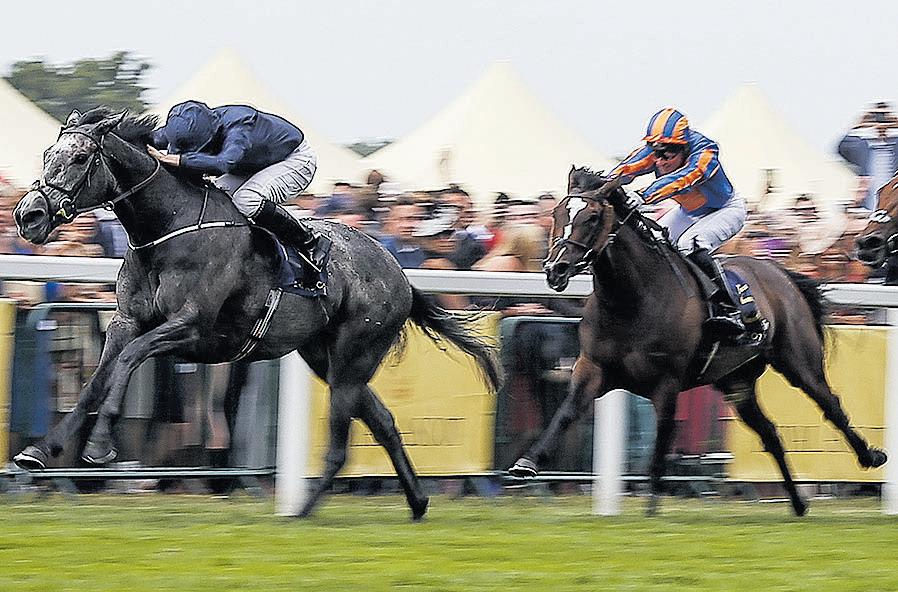

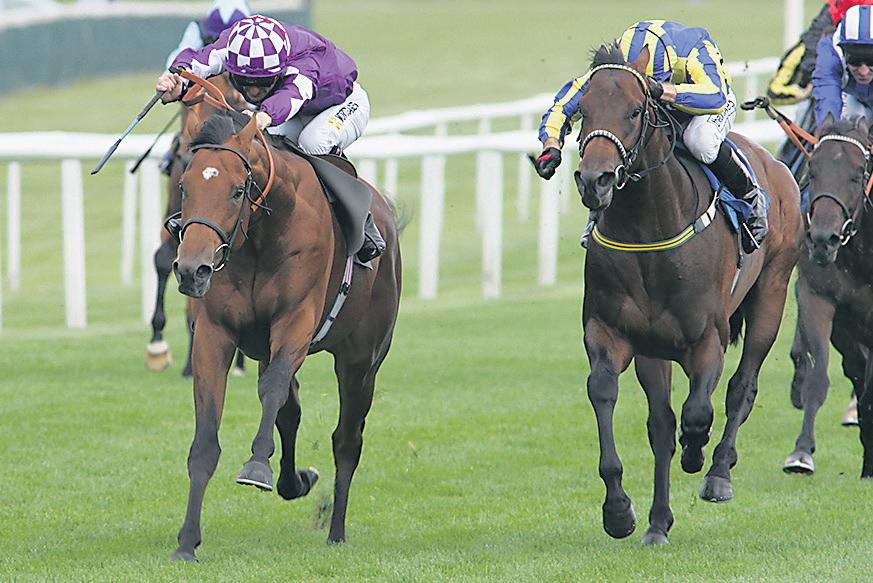
Choisir continued covering in Australia until being retired in 2019, and he died in December 2021, prompting a wave of warm obituaries celebrating a pioneer in international racing.
His stud record in the southern hemisphere was arguably even better than in the north, not least because it was topped by an apple that didn’t fall far from the tree, in the shape of Starspangledbanner.
The chestnut was useful at two, when he won an Inglis sales race and ran third in the Blue Diamond Prelude, and showed significant improvement and admirable versatility at three, when he took the Caulfield Guineas over a mile and the Oakleigh Plate over five and a half furlongs. He also finished third in the Newmarket Handicap and fourth in the Lightning Stakes that season.
Those efforts caught the attention of Coolmore, who snapped up a majority share in the colt and brought him to be trained by Aidan O’Brien at Ballydoyle. He ignited memories of

his sire by making all the running in the Golden Jubilee Stakes and went one better than Dad by doing the same to win the July Cup.
CHOISIR’S southernhemisphere crops also produced Australasian Group 1 winners Choice Bro, Divine Prophet, Historian, Japonisme, Kushadasi, Sacred Choice, Snapdancer and The Mission, as well as Hong Kong stars Luger and Secret Weapon.
All told, he sired 56 Group/Graded winners, 47 Listed scorers and 84 other black-type performers. Not bad for a horse with a modest pedigree, who never stood at a fee higher than €15,000 in Ireland or A$35,750 (£19,175/€22,400) in Australia.
Even better, he is developing a considerable influence on the breed through his sons and daughters, which could arguably be a result of more classical and refined blood being mingled with his.
Starspangledbanner has been something of a bellwether for Choisir in this respect, too, in spite of suffering from subfertility during his early years at stud. He sired a debut northern-hemisphere crop numbering just 33 foals, but it contained two Royal Ascot juvenile winners in The Wow Signal and Anthem Alexander, as well as further stakes scorers Great Wide Open, Home Of The Brave, Last Gift, Meliora, Silver Rainbow and Spangled.
Starspangledbanner’s second Irish-bred crop amounted to only eight foals, but six winners, and after a spell of not shuttling from Australia he returned to Coolmore in Fethard to great fanfare in 2015, with his fertility issues evidently fixed. His subsequent larger northern-hemisphere crops include Cheveley Park Stakes winner Millisle and Group 1-placed two-year-olds Aloha Star, Castle Star and Flotus.
More recently, he has shown he isn’t just about speed and precocity, with State Of Rest winning the Saratoga Derby, Cox Plate, Prix Ganay and Prince of Wales’s Stakes before retiring to Rathbarry Stud, California Spangle shining over a mile to nine furlongs in Hong Kong, Aristia scoring in the Prix
Jean Romanet, and Rhea Moon taking the American Oaks.
Starspangledbanner, who stood at a career-high fee of €50,000 at Coolmore in Ireland this season, has 20 Pattern winners, ten Listed scorers and 25 other black-type performers on his record. Those figures look set to soar in the coming years.
History repeated itself a little last year when Rajasinghe, another Choisir stallion son, produced an eye-popping strike-rate with his small debut crop of two-year-olds. He fielded eight winners from just ten runners, including the Listed-placed Waiting All Night, and he is reportedly in more demand at the National Stud this year at a fee of just £3,000.
Choisir’s third son on active duty in Europe this year, Olympic Glory, has been a bit hit and miss since his first juveniles reached the track five years ago, but he has proved with the Group 1-winning fillies Grand Glory and Watch Me that he is capable of getting one out of the top drawer, and he possibly represents value at a fee of €4,000 at Haras de Bouquetot in Normandy. Even some of Choisir’s sire sons who didn’t stand the test of
Saturday, June 17, 2023 racingpost.com 6
‘It is no exaggeration to say that Choisir’s two victories in the space of five days at Royal Ascot in 2013 shaped the direction of world breeding’
20 YEARS ON THE WORLDWIDE LEGACY TO THE BLOODSTOCK
WORLD
created a dynasty
Master, Pizza Bianca, Qualify, Rivet and Zhukova; and Exceed And Excel, who provided Excelebration, Margot Did, Mischief Magic, Outstrip and this season’s 1,000 Guineas heroine Mawj.
The best Australian racemares also became hot property among breeders on the global stage, often to bring some Choisir-esque grit to matings with more classically bred sires.
Blue Diamond Prelude winner Believe’N’Succeed, a daughter of Exceed And Excel who was already the dam of New Zealand Group 1winning sprinter Bounding, was bought to be mated with Galileo at Coolmore in Ireland and produced no less than a Derby winner in Anthony Van Dyck from one such tryst. Bounding, meanwhile, was bought by Stonestreet Farm in Kentucky, for whom she has delivered a couple of winners.
Hveger, a Group 1-placed Danehill full-sister to one great Aussie globetrotter in Elvstroem and half-sister to another in Haradasun, was also taken to Ireland to be a regular concubine for Galileo. The match produced four Pattern winners, including elite scorers Highland Reel and Cape Of Good Hope, as well as the placed mare Cercle De La Vie, who became the dam of dual Group 1-winning two-year-old Angel Bleu.
In the family: Choisir’s sons, daughters and grandchildren in winning action (clockwise, from top left): Stimulation, Olympic Glory, The Last Lion, My Dream Boat, Persuasive, Winter and Starspangledbanner
time on stud rosters managed to get the odd good one, not least former Llety Stud resident Stimulation, who supplied Sagaro Stakes scorer Sweet Selection and smart two-year-olds Dave Dexter and Union Rose. Divine Prophet, who briefly shuttled to Tara Stud, and ill-fated Darley sire The Last Lion also left a few useful winners between them.
Divine Prophet’s full-brother Proisir, who finished a close second to Dundeel in the Spring Champion Stakes and Randwick Guineas, is, meanwhile, one of the most respected young stallions in the southern hemisphere.
He is already booked out this year at Rich Hill Stud in New Zealand at NZ$70,000 (£34,000/€40,000), ten times his introductory fee, after siring Group 1 winners Dark Destroyer, Legarto, Levante, Pier and Prowess, plus Group 1-placed Aspen Colorado, Feel The Rush, Riodini, Vancooga and Waitak from just 230 runners. He is on course to claim his first New Zealand sire title by a margin of around NZ$1.5 million.
Divine Prophet, who formerly carried out southern-hemisphere stud duty at Aquis Farm in Australia, is moving to Highview Stud in New
Zealand this year to capitalise on his brother’s popularity.
Starspangledbanner at Coolmore and State Of Rest at Newgate Farm are the principal standard-bearers for the Choisir sire-line in Australia, although The Mission and Worthy Cause have delivered Group winners at small fees in lower-profile roles elsewhere in the country.
Choisir’s achievements as a broodmare sire continue to grow, too.
His highest-earning maternal grandchild is Winter, winner of the Newmarket and Curragh 1,000 Guineas, Coronation Stakes and Nassau Stakes. Coolmore’s homebred filly is by Galileo out of Laddies Poker Two, another Royal Ascot success for her sire when landing a gamble in the Wokingham Handicap in 2010.

Choisir’s uncanny affinity with Ascot is seen in many of the other Group 1 winners his daughters have produced. Creative Force, by Dubawi out of Choose Me, won the British Champions Sprint at the track and was beaten a neck into second by Naval Crown in the Platinum
Jubilee Stakes at the royal meeting last year, while his Dark Angel halfsister Persuasive landed the Sandringham Handicap at Royal Ascot before taking the scalps of Ribchester and Churchill in the Queen Elizabeth II Stakes at the royal racecourse.

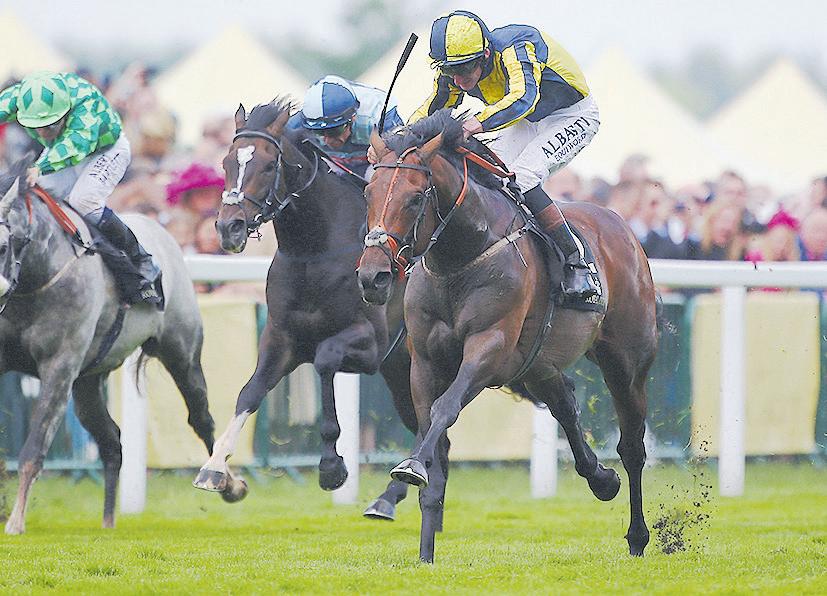
MOREOVER, Oxted (below) – by Mayson out of Charlotte Rosina – won the King’s Stand Stakes and My Dream Boat – by Lord Shanakill out of Betty Burke – sprang a surprise in the Prince of Wales’s Stakes there.

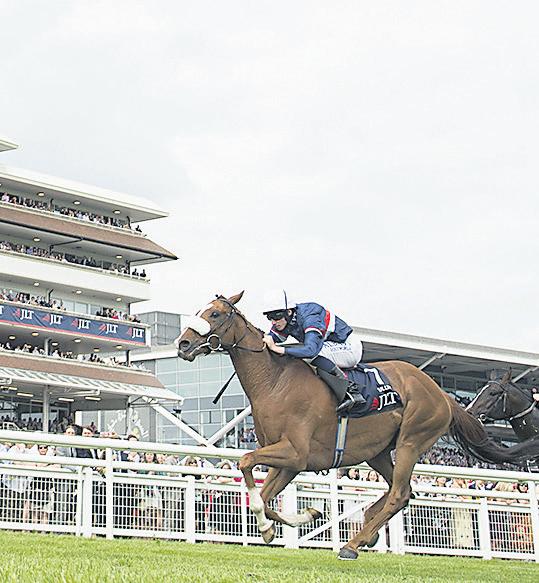
Choisir is also the damsire of Australia’s latest sprint sensation In Secret, who struck in the Coolmore Stud Stakes in November and took the Newmarket in March. Godolphin’s three-year-old filly is by I Am Invincible out of Group 3-winning sprinter Eloping.
Another bright prospect for the sire in this department is the Jean-Claude Rouget-trained two-year-old filly Voodoo Magic, who scored by clear water on her debut at Longchamp last month. She is by Wootton Bassett out of Fille Du Septembre, who won a maiden over the minimum trip at Dundalk on her own first outing. Choisir’s daughters have proved perfect for sharpening up stamina influence Galileo, with the cross producing seven winners and four
black-type performers from just eight runners. They also appear to complement Australian champion sire I Am Invincible, as the nick is responsible for six winners and three black-type horses from seven starters.
At a more realistic level, Dream Ahead and Magnus are two other sires to bear in mind for Choisir mares. Previous matings on those lines have produced six winners from seven runners (including Creative Force and Persuasive’s Listed-winning half-sister Tisbutadream) and four winners from four runners respectively.
Choisir’s influence goes further than his own achievements as a sire, sire of sires and broodmare sire, though. There is no doubt that he contributed to a heightened respect of Australian bloodlines in the new millennium, which has seen the AUS suffix appear in the pedigrees of big-race winners all around the world.
In the afterglow of his groundbreaking Royal Ascot double, more and more Australian horses travelled north to take their chances at the meeting, and many of those or other countrymen were shuttled north to cover mares in European studs.
Two champion sires at home in Australia have made a particularly significant impact on breeding in Europe: Fastnet Rock, on the mark with Irish-conceived Group 1 winners Diamondsandrubies, Fascinating Rock, Intricately, Laganore, One
MANY other top-class Australian-bred racemares were also paired with Galileo in Europe in the last decade. Atlantic Jewel sparked with the son of Sadler’s Wells in spectacular fashion, producing Hong Kong star Russian Emperor, while Milanova bred Group 3 winner Pretty Perfect from him, and Nechita delivered Forbearance on the cross.
Furthermore, two of the best fillies or mares anywhere in the northern hemisphere this year are by other sires out of elite Australian mares.
Liberty Island, who has landed the Japanese 1,000 Guineas and Oaks, the latter by six lengths, was bred by Northern Farm by sending Yankee Rose, a daughter of All American who won the Inglis Sires’ and Spring Champion Stakes, to Duramente.
In Italian, who left her rivals for dead in the Just A Game Stakes at Belmont Park this month, is, meanwhile, by Dubawi out of Florentina, a Group 3-winning daughter of Redoute’s Choice. She was bred in Britain by Australian John Camilleri and sold to US owner Peter Brant for 475,000gns at Book 1 of the Tattersalls October Yearling Sale in a transaction that highlights the international appeal of Australian breeding.
So, all things considered, it’s no exaggeration to say that Choisir’s two victories in the space of five days at Royal Ascot in 2003 helped shape the direction of world breeding in the new millennium. The stocky chestnut, memorably once compared by his connections with a Brahma bull, has fittingly left a huge legacy.
Racing Post Saturday, June 17, 2023 7
CHOISIR 20 YEARS ON AUSTRALIA – LAND OF RACING OPPORTUNITY
‘If expats work hard, they have the chance to be successful’
Tim Rowe talks to some young stars of the training ranks
BRITON Annabel
Neasham, knocked back for a pupil assistant’s role in the UK seven years ago, embarked on an around-the-world working holiday to gain more experience in the racing industry.
Her first stop was Sydney. The US was to be next, but she never left Australia, venturing to Victoria’s capital Melbourne, but no further.
Neasham, from Croughton in Northamptonshire, is among a cohort of young, talented and ambitious British trainers taking Australian racing by storm, and raking in the riches that go with it.
David Eustace, the son of retired Newmarket trainer James and brother of Harry, also made the trip to Australia to further his career. He is now one half of the racing behemoth that is Ciaron Maher Racing, the juggernaut that has trained 11 Group 1 winners this season and on July 31 will be crowned Australia’s premier stable by winners for the first time.
Eustace, 31, who played a key role in setting Australia’s Group 1-winning colt Merchant Navy on his way to Royal Ascot glory in 2018, co-trains Tuesday’s King’s Stand contender Coolangatta.
As it happens, Neasham, 32, worked for Maher and Eustace during her “equine education” and she could have easily remained within the pair’s rather large safety net as their Sydney assistant (or even entered into a training triumvirate), but instead she decided to go it alone.
Her bold move – with the initial backing of big-spending Hong Kong owner Tony Fung – paid off as Neasham has quickly become one of
the biggest names in Sydney racing, and prominent domestic and international investors have since flocked to her Warwick Farm stable craving a piece of the action – and the prize-money.

It will be three years this August since Neasham trained her first winner, a maiden at Scone in Australia’s breeding heartland of the Hunter Valley, and she hasn’t stopped since. She has eight Group 1 winners to her name – stallion prospect Mo’unga and European import Zaaki chiefly among them – and her runners have earned almost A$38 million (£20.4m) for connections, an almost impossible figure for British racing participants to comprehend, and Australian trainers are entitled to ten per cent of prize-money earned.
“I came here on a working holiday-visa, planning to do a year here and a year in America and then try to get an assistant trainer’s job back home,” Neasham recalls of
initially being rebuffed in her home nation and relocating to Australia.
“I thought by travelling all over the place I’d have a better CV and I’d be able to get a better job, but I never got beyond here because I realised how much more opportunity there was.”
IN HIS 21 starts in Europe (and one in Hong Kong), Zaaki earned £223,744 in prizemoney. In his 22 starts since, all under Neasham, he has earned A$9.9 million (£5.319m).
“I didn’t expect to get this big this quickly, but people seem to love giving young, new trainers an opportunity and I suppose we’re just trying to grab that with both hands,” Neasham says.
“I struck gold getting Zaaki, he was really the first horse I bought, so I couldn’t have asked for a better horse to come into my stable at the right time, so that probably helped accelerate everything.”
In Victoria, expatriate Brits Matt Cumani, son of former trainer Luca, and Archie Alexander, son of agent Hamish, have carved out excellent training careers at Ballarat after taking the leap of faith that Australian racing was where they were best placed to achieve racing prosperity.
Alexander and Cumani have so far trained more than 650 winners between them and both have prepared multiple black-type scorers.
Cumani – still waiting for his Australian citizenship and who will be cheering for his adopted country’s line-up at Royal Ascot but not at Lord’s – has no regrets about setting up business in Australia.
Prize-money was the obvious initial attraction to Australia for Cumani, who spent time working under his famous father and fellow Newmarket trainer Ed Dunlop, Todd Pletcher in the US and Chris Waller in Sydney, before opening his Ballarat yard.
“If expatriates work hard and have
an ambition to do it, they all have the chance to be trainers or other very successful racing pursuits when they come down here to Australia,” Cumani says.
“That barrier to entry is a lot lower in Australia than it is in the UK, not only from a cost point of view but also from an acceptance point of view.
“Here, if you work hard and stick to it, and you’re good at what you do, you have a better chance of making it than you do in the UK.”
It’s said Aussies will bet on two flies climbing up a wall, such is the country’s love of a punt, and now confirmed Sydneysider Neasham says racing is certainly more front of mind in Australia.
“The return on investment [by owning horses] is so much better in Australia . . . because it’s pretty slim back home. I think that obviously attracts more and more people into racing and that’s what really struck me about the average person you meet in a pub in Australia,” Neasham said.
“If they don’t have a share in a horse, they still follow racing, it’s part of the culture here in Australia.
“A lot of my mates back home wouldn’t follow racing at all whereas here, a lot of my non-horse friends, watching the Saturday races is part of it just as much as watching the footy is. It’s one of the main sports.”
Providing a high-quality ownership experience is another thing Cumani and Neasham agree on.
“We try to make it a good experience for the owners, whether they’ve got one per cent or 100 per cent of the horse,” Neasham said.
“You want them to feel part of the journey. It’s very time-consuming for us; it’s a big part of the business, but it’s what attracts people, so we’ve got to try to do a good job so people enjoy the experience.”
There is no better place to race a horse than in Australia
THERE is no better place to race a horse than in Australia where there is more than A$800 million in prize-money up for grabs annually and where a race worth A$1m or more is run, on average, every three and a half days.
Aushorse chief executive Tom Reilly, an expatriate Englishman himself, is convinced the Australian industry stacks up better than anywhere else in the world to own part of, or outright, a thoroughbred racehorse.
There are more than 100,000 people in Australia who own shares in a racehorse.


“Everyone knows that we’ve got a great funding mechanism that delivers prize-money that is pretty much unequalled in
most parts of the world, but there’s also great engagement with racing in Australia and that’s something that when owners go racing from overseas they realise how big racing is as a sport here in Australia,” Reilly said.
“We get a lot of feedback from people, they really enjoy the experience.
“Because we have large groups of owners for a long time, our trainers do an amazing job keeping people engaged with their horses, even if they’re on the other side of the world. I have had people who have studs in Newmarket tell me they’re better informed about their horses in Sydney and Melbourne than they are
about their horses down the road.
“It is a great opportunity for people to become engaged in the industry in Australia because it’s going from strength to strength.”
International powerhouse Coolmore and rival Godolphin have been long-term investors in the Australian industry, each running their own stud farms and racing operations, while the country has become the base for Yulong and its owner Zhang Yuesheng, a man who in recent years has cast a shadow like no other in terms of investment in bloodstock globally the likes of which we’ve never seen before.
But it’s the newer international entities and
owners who have recognised the value and return on investment to be gained by racing in Australia.
They include South Africa’s Gary Barber, Sheikh Khalifa Al Maktoum, Japan’s Northern Farm, LNJ Foxwood from the US, Qatar Racing’s Sheikh Fahad, who is a part-owner of reverse shuttle sire Zoustar, and Teme Valley, which won the 2021 Cox Plate with State Of Rest and races the Annabel Neasham-trained Numerian in Australia.
Sheikh Mohammed Obaid Al Maktoum has also tasted success down under in his early racing foray, with the former Simon and Ed Crisfordtrained Group 3 Silver Cup Stakes winner Without A Fight
making it two for two this preparation in Queensland for Anthony and Sam Freedman, putting historic Australian races the Caulfield Cup, Melbourne Cup and Cox Plate on the agenda in the southern hemisphere spring.
Without A Fight banked A$836,000 (£449,150) in his brief Brisbane winter campaign and in doing so became another member of the one-in-57 horses in Australia to have career earnings above A$500,000.
Australia’s auction houses and vendors also lay on the hospitality at the respective sales around the country, ensuring important bloodstock trade events are an enjoyable part of doing business.
“If you go to the Gold Coast for the Magic Millions and you’re on the beach during an Australian summer, it is a great festival in a relaxed atmosphere with everyone having a wonderful time, or if you come for Inglis’s Sydney Easter sale, then you’re staying in one of the greatest cities with some of the best restaurants in the world,” Reilly said.
“Between the sales, the companies and the vendors, and the racing industry as a whole, people receive a great welcome and that’s why we have them come out once and they keep coming back again because they enjoy it so much.”
Saturday, June 17, 2023 racingpost.com 8
The place to be: Zaaki (far left) enjoys a stroll on the beach; trainers Matt Cumani and Annabel Neasham
TIM ROWE

















































































